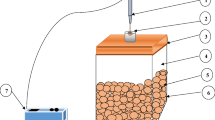Abstract
Models based on mass balances and Michaelis-Menten respiration kinetics are increasingly used to determine optimal storage conditions of fresh fruits and vegetables. The model parameters are usually estimated from respiration experiments at different, but fixed, gas conditions according to a response surface design. This is a tedious procedure that requires a gas mixing facility or a series of gas cylinders with appropriate composition. In this paper, we consider a simpler approach, in which the respiration kinetics of pear fruit are modeled using a single experiment with a time-varying O2 input profile. To optimize the information content produced by the O2 profile, we apply optimal dynamic experimental design principles and present a modified coordinate-exchange algorithm to achieve this goal. Finally, we demonstrate the added value of our approach by comparing the optimal O2 input profiles to several intuitive benchmark experiments.












Similar content being viewed by others
References
Atkinson, A., Donev, A., Tobias, R. (2007). Optimum experimental designs, with SAS Vol. 34. Oxford: Oxford University Press.
Balsa-Canto, E., Alonso, A.A., Banga, J.R. (2010). An iterative identification procedure for dynamic modeling of biochemical networks. BMC Systems Biology, 4(1), 11.
Balsa-Canto, E., Rodriguez-Fernandez, M., Banga, J.R. (2007). Optimal design of dynamic experiments for improved estimation of kinetic parameters of thermal degradation. Journal of Food Engineering, 82(2), 178–188.
Bauer, I., Bock, H.G., Körkel, S., Schlöder, J.P. (2000). Numerical methods for optimum experimental design in DAE systems. Journal of Computational and Applied Mathematics, 120(1-2), 1–25.
Berg, J.M., Tymoczko, J.L., Gatto, G. Jr. (2002). Biochemistry, WH Freeman.
Bernaerts, K., Servaes, R.D., Kooyman, S., Versyck, K.J., Van Impe, J.F. (2002). Optimal temperature input design for estimation of the square root model parameters: parameter accuracy and model validity restrictions. International Journal of Food Microbiology, 73(2), 145–157.
Bernaerts, K., Versyck, K.J., Van Impe, J.F. (2000). On the design of optimal dynamic experiments for parameter estimation of a Ratkowsky-type growth kinetics at suboptimal temperatures. International Journal of Food Microbiology, 54(1), 27–38.
Bessemans, N., Verboven, P., Verlinden, B., Nicolaï, B.M. (2016). A novel type of dynamic controlled atmosphere storage based on the respiratory quotient (RQ-DCA). Postharvest Biology and Technology, 115, 91–102.
Chaloner, K., & Verdinelli, I. (1995). Bayesian experimental design: a review. Statistical Science, 10(3), 273–304.
Efron, B., & Hastie, T. (2016). Computer age statistical inference. Cambridge: Cambridge University Press.
Fedorov, V.V., & Leonov, S.L. (2013). Optimal design for nonlinear response models. Boca Raton: CRC Press.
Fidler, J., & North, C. (1967). The effect of conditions of storage on the respiration of apples: I. the effects of temperature and concentrations of carbon dioxide and oxygen on the production of carbon dioxide and uptake of oxygen. Journal of Horticultural Science, 42(2), 189–206.
Fonseca, S.C., Oliveira, F.A., Brecht, J.K. (2002). Modelling respiration rate of fresh fruits and vegetables for modified atmosphere packages: a review. Journal of Food Engineering, 52(2), 99–119.
Goos, P., & Jones, B. (2011). Optimal design of experiments: a case study approach. Chichester: Wiley.
Hertog, M.L., Peppelenbos, H.W., Evelo, R.G., Tijskens, L.M. (1998). A dynamic and generic model of gas exchange of respiring produce: the effects of oxygen, carbon dioxide and temperature. Postharvest Biology and Technology, 14(3), 335–349.
Ho, Q.T., Hertog, M.L., Verboven, P., Ambaw, A., Rogge, S., Verlinden, B.E., Nicolaï, B.M. (2018). Down-regulation of respiration in pear fruit depends on temperature. Journal of Experimental Botany, 69 (8), 2049–2060.
Ho, Q.T., Verboven, P., Verlinden, B.E., Herremans, E., Wevers, M., Carmeliet, J., Nicolaï, B.M. (2011). A three-dimensional multiscale model for gas exchange in fruit. Plant Physiology, 155(3), 1158–1168.
Jacxsens, L., Devlieghere, F., De Rudder, T., Debevere, J. (2000). Designing equilibrium modified atmosphere packages for fresh-cut vegetables subjected to changes in temperature. LWT-Food Science and Technology, 33(3), 178–187.
Lammertyn, J., Scheerlinck, N., Jancsok, P., Verlinden, B.E., Nicolaï, B.M. (2003). A respiration–diffusion model for conference pears: II. simulations and relation to core breakdown. Postharvest Biology and Technology, 30 (1), 43–55.
Meyer, R.K., & Nachtsheim, C.J. (1995). The coordinate-exchange algorithm for constructing exact optimal experimental designs. Technometrics, 37(1), 60–69.
Michaelis, L., & Menten, M.L. (1913). Die Kinetik der Invertinwirkung, vol. 49, Universitätsbibliothek Johann Christian Senckenberg.
Munack, A., & Posten, C. (1989). Design of optimal dynamical experiments for parameter estimation. In American control conference, 1989 (pp. 2010–2016): IEEE.
Nahor, H.B., Scheerlinck, N., Van Impe, J.F., Nicolaï, B.M. (2003). Optimization of the temperature sensor position in a hot wire probe set up for estimation of the thermal properties of foods using optimal experimental design. Journal of Food Engineering, 57(1), 103–110.
Nahor, H.B., Scheerlinck, N., Verniest, R., De Baerdemaeker, J., Nicolaï, B.M. (2001). Optimal experimental design for the parameter estimation of conduction heated foods. Journal of Food Engineering, 48(2), 109–119.
Peppelenbos, H.W., & van’t Leven, J. (1996). Evaluation of four types of inhibition for modelling the influence of carbon dioxide on oxygen consumption of fruits and vegetables. Postharvest Biology and Technology, 7(1-2), 27–40.
Saltveit, M.E. (2003). Is it possible to find an optimal controlled atmosphere? Postharvest Biology and Technology, 27(1), 3–13.
Shampine, L.F., & Reichelt, M.W. (1997). The Matlab ODE suite. SIAM Journal on Scientific Computing, 18(1), 1–22.
Telen, D., Logist, F., Van Derlinden, E., Tack, I., Van Impe, J. (2012). Optimal experiment design for dynamic bioprocesses: a multi-objective approach. Chemical Engineering Science, 78, 82–97.
Vassiliadis, V.S. (1993). Computational solution of dynamic optimization problems with general differential-algebraic constraints, PhD thesis, Imperial College, University of London.
Acknowledgements
Author Arno Strouwen is a PhD fellow Strategic Basic Research (SB) of the Fund for Scientific Research, Flanders (FWO), project 1S58717N.
Funding
The authors received financial support from KU Leuven (project C16/16/002).
Author information
Authors and Affiliations
Corresponding author
Additional information
Publisher’s Note
Springer Nature remains neutral with regard to jurisdictional claims in published maps and institutional affiliations.
Rights and permissions
About this article
Cite this article
Strouwen, A., Nicolaï, B.M. & Goos, P. Optimizing Oxygen Input Profiles for Efficient Estimation of Michaelis-Menten Respiration Models. Food Bioprocess Technol 12, 769–780 (2019). https://doi.org/10.1007/s11947-019-02250-w
Received:
Accepted:
Published:
Issue Date:
DOI: https://doi.org/10.1007/s11947-019-02250-w




